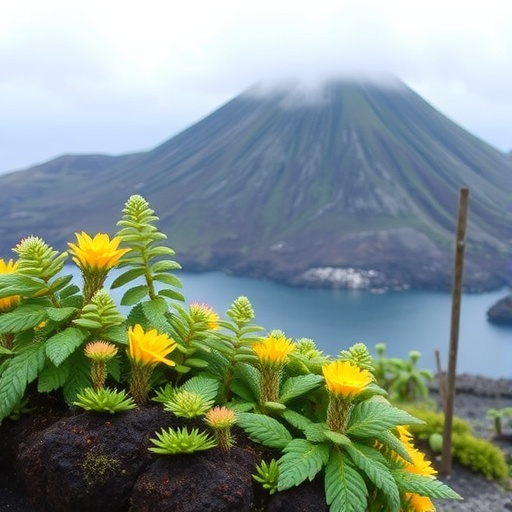Tokyo, Japan — In one of the most compelling studies on island biogeography and genetic evolution to date, researchers from Tokyo Metropolitan University have unveiled the genetic origins of a now-extinct population of the common purslane plant (Portulaca oleracea) from Nishinoshima, a volcanic island marked by periodic eruptions that obliterate its vegetation and reset its ecological clock. This investigation not only sheds light on the lineage and genetic distinctiveness of this isolated population but also reveals the profound effects of founder events and genetic drift during the nascent stages of ecosystem establishment on remote volcanic landforms.
Nishinoshima, part of the Ogasawara archipelago located approximately 1,000 kilometers south of Tokyo’s mainland, is a site of active volcanism, with significant eruptions reshaping its landscape and biota repeatedly. The 2013 eruption drastically devastated the island’s plant life, effectively erasing established communities and allowing scientists a rare opportunity to trace the recolonization and genetic history of species such as common purslane that arrive on the island post-eruption. This cyclical destruction and regeneration create a unique natural laboratory to understand early-stage ecosystem assembly and evolutionary dynamics under isolation and disturbance regimes.
Led by Professor Koji Takayama, previously affiliated with Kyoto University and now at Tokyo Metropolitan University, the team analyzed plant samples collected from Nishinoshima shortly before a 2019 eruption permanently decimated the local purslane population. The study incorporated a comprehensive genetic comparison using 254 individual samples collected across 51 populations from the Japanese mainland to Guam, encompassing a wide geographic range that facilitated a robust phylogeographic framework for differentiation and origin tracing.
Employing both chloroplast genome sequencing and extensive nuclear DNA genotyping, researchers constructed a detailed phylogenetic tree elucidating the evolutionary relationships within Portulaca oleracea populations. Their analysis conclusively established that Nishinoshima’s population was genetically most proximate to populations on Chichijima, another volcanic island within the Ogasawara chain. Yet, despite this close relationship, distinctive genetic characteristics were identified, emphasizing unique evolutionary trajectories attributed to the island’s isolation and the stochastic nature of colonization events.
One of the most salient discoveries was the pronounced founder effect observed in the Nishinoshima purslane population. This evolutionary phenomenon, where new populations arise from a small number of colonizing individuals, leads to reduced genetic variation and distinct allele frequencies compared to source populations. This effect underscores how even minuscule propagule sizes can dramatically influence genetic divergence and adaptation pathways in isolated environments, especially those subject to recurrent catastrophic disturbances like volcanic eruptions.
Seeds of common purslane, being diminutive (less than one millimeter) and possessing a flat, oblate morphology, are inherently well-suited for dispersal via abiotic and biotic vectors, including wind, water currents, and avian carriers. However, the strength of the founder effect, alongside evidence for genetic drift amidst these island populations, suggests that successful colonization is an exceedingly rare and stochastic event. This indicates that physical dispersal capabilities do not necessarily translate into frequent or reliable establishment on harsh, unpredictable terrains such as those of Nishinoshima.
Genetic drift, a mechanism causing random fluctuations in allele frequencies independent of selective pressures, emerged as a dominant force shaping the genetic structure of this population. Given the island’s vulnerability to typhoons, volcanic eruptions, and other environmental perturbations, genetic drift rather than natural selection appeared to be the principal driver behind observed genetic changes. This insight complicates classical views of adaptation by highlighting the role of chance events in evolutionary trajectories during early colonization phases.
The implications of these findings extend beyond a single plant species or island ecosystem, offering a valuable model for understanding how ecosystems assemble, evolve, and recover following major natural disturbances. The study captures a dynamic snapshot of genetic colonization under extreme conditions, revealing processes that are foundational to biodiversity formation and maintenance in isolated and frequently disturbed habitats. This knowledge could inform conservation strategies aiming to preserve or restore species diversity in similarly volatile environments worldwide.
Furthermore, the study illustrates the pivotal role of phylogenetics and modern genomic tools in resolving questions about species origin and population dynamics in cryptic or transient populations. By integrating chloroplast and nuclear genetic data, the researchers achieved a multi-layered perspective on the evolutionary history and demographic events that traditional morphological or limited genetic markers might overlook, thus pushing forward the frontier of island evolutionary biology.
This research underscores the extraordinary resilience and adaptability of pioneer species like Portulaca oleracea, which despite frequent extinction events, continually reestablish themselves through rare but effective long-distance dispersal and colonization. Investigations into such species deepen our comprehension of how life persists and diversifies against a backdrop of environmental stochasticity and geological upheaval, enriching our understanding of the fundamental principles that govern biodiversity and ecosystem stability.
As volcanic islands like Nishinoshima serve as microcosms for the study of evolutionary forces, this work contributes significantly to the emerging field of disturbance ecology and its genetic underpinnings. Exploring how founder effects, genetic drift, and limited gene flow collectively fashion new populations lends crucial perspective to global patterns of species distribution, phylogeography, and the consequences of habitat destruction and renewal under climate change.
Finally, the findings provide a cautionary note on the fragility and transience of island populations under natural disaster regimes and the importance of monitoring genetic diversity as an indicator of ecosystem health and resilience. With further research, the principles uncovered here could guide efforts to anticipate the vulnerabilities and recovery potentials of island biotas facing escalating natural and anthropogenic disturbances in the 21st century.
Subject of Research: Phylogenetic origin and genetic evolution of Portulaca oleracea populations on an active volcanic island
Article Title: Origin of populations of Portulaca oleracea on Nishinoshima, an active volcanic oceanic island
News Publication Date: 28-Jul-2025
Web References: DOI link
Image Credits: Tokyo Metropolitan University
Keywords: Habitat diversity, Plant genetics, Volcanic eruptions, Genetic drift, Phylogenetic analysis, Gene identification, Evolutionary biology, Biodiversity, Natural disasters, Seed dispersal, Species distribution




